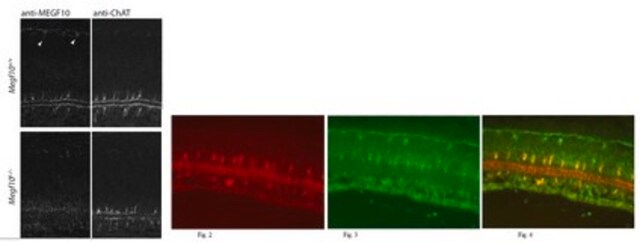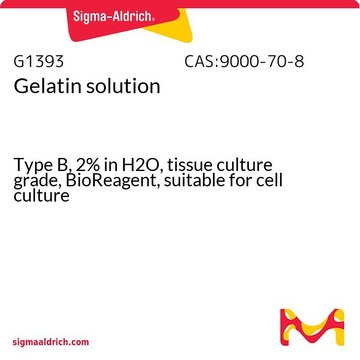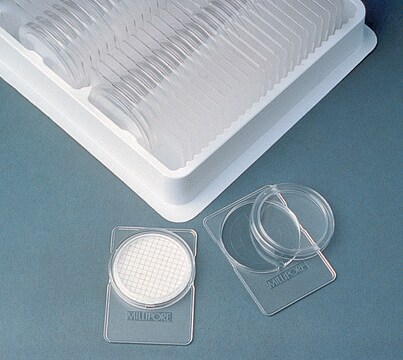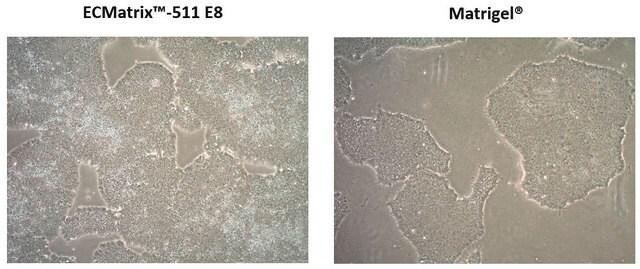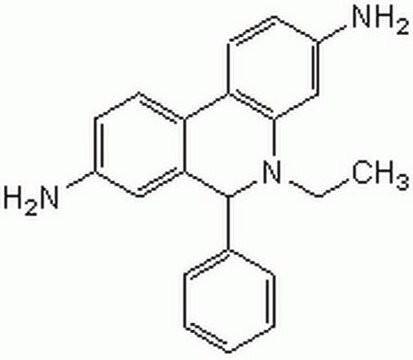おすすめの製品
由来生物
rabbit
品質水準
抗体製品の状態
serum
抗体製品タイプ
primary antibodies
クローン
polyclonal
化学種の反応性
mouse
メーカー/製品名
Chemicon®
テクニック
immunocytochemistry: suitable
immunohistochemistry: suitable
western blot: suitable
NCBIアクセッション番号
UniProtアクセッション番号
輸送温度
dry ice
ターゲットの翻訳後修飾
unmodified
遺伝子情報
mouse ... Pkd2(18764)
特異性
Polycystin-L
免疫原
Synthetic peptide from the N-terminal of human Polycystin-L1.
アプリケーション
Research Category
代謝
代謝
Research Sub Category
腎生理学
腎生理学
This Anti-Polycystin-L Antibody is validated for use in WB, IC, IH for the detection of Polycystin-L.
Western blot: 1:1,000 using ECL. The antibody reacts with the 90 kDa Polycystin1-L1 protein. Suggested blocking buffer is 10% normal goat serum (or same host as your secondary antibody), 1% BSA in 0.1M PBS with 0.05% Tween 20. Suggested dilution buffer is 1% normal goat serum (or same host as your secondary antibody), 1% BSA in 0.1M PBS with 0.05% Tween 20. Preferred gel percentage is 4-12% gradient gel.
Immunocytochemistry: 1:1,000
Immunohistochemistry: 1:1,000 overnight at 2-8°C using a fluorescently labeled secondary antibody. Suggested fixative is 4% paraformaldehyde in 0.1M PBS (one hour). Suggested permeablization method is 0.05% Triton X-100 in dilution buffer. Suggested blocking buffer is 10% normal goat serum (or same host as your secondary antibody) and 1% BSA in 0.1M PBS. Suggested dilution buffer is 1% normal goat serum (or same host as your secondary antibody) and 1% BSA in 0.1M PBS.
Optimal working dilutions must be determined by the end user.
Immunocytochemistry: 1:1,000
Immunohistochemistry: 1:1,000 overnight at 2-8°C using a fluorescently labeled secondary antibody. Suggested fixative is 4% paraformaldehyde in 0.1M PBS (one hour). Suggested permeablization method is 0.05% Triton X-100 in dilution buffer. Suggested blocking buffer is 10% normal goat serum (or same host as your secondary antibody) and 1% BSA in 0.1M PBS. Suggested dilution buffer is 1% normal goat serum (or same host as your secondary antibody) and 1% BSA in 0.1M PBS.
Optimal working dilutions must be determined by the end user.
アナリシスノート
Control
POSITIVE CONTROL: adult mouse retina
NEGATIVE CONTROL: adult mouse lung
POSITIVE CONTROL: adult mouse retina
NEGATIVE CONTROL: adult mouse lung
法的情報
CHEMICON is a registered trademark of Merck KGaA, Darmstadt, Germany
免責事項
Unless otherwise stated in our catalog or other company documentation accompanying the product(s), our products are intended for research use only and are not to be used for any other purpose, which includes but is not limited to, unauthorized commercial uses, in vitro diagnostic uses, ex vivo or in vivo therapeutic uses or any type of consumption or application to humans or animals.
適切な製品が見つかりませんか。
製品選択ツール.をお試しください
保管分類コード
10 - Combustible liquids
WGK
WGK 1
引火点(°F)
Not applicable
引火点(℃)
Not applicable
適用法令
試験研究用途を考慮した関連法令を主に挙げております。化学物質以外については、一部の情報のみ提供しています。 製品を安全かつ合法的に使用することは、使用者の義務です。最新情報により修正される場合があります。WEBの反映には時間を要することがあるため、適宜SDSをご参照ください。
Jan Code
AB9084:
試験成績書(COA)
製品のロット番号・バッチ番号を入力して、試験成績書(COA) を検索できます。ロット番号・バッチ番号は、製品ラベルに「Lot」または「Batch」に続いて記載されています。
Qiang Su et al.
Nature communications, 12(1), 4871-4871 (2021-08-13)
The heteromeric complex between PKD1L3, a member of the polycystic kidney disease (PKD) protein family, and PKD2L1, also known as TRPP2 or TRPP3, has been a prototype for mechanistic characterization of heterotetrametric TRP-like channels. Here we show that a truncated
Polycystin-2 expression and function in adult mouse lacrimal acinar cells.
Kaja, S; Hilgenberg, JD; Rybalchenko, V; Medina-Ortiz, WE; Gregg, EV; Koulen, P
Investigative Ophthalmology & Visual Science null
Elham Jalalvand et al.
eLife, 11 (2022-02-02)
Cerebrospinal fluid-contacting (CSF-c) neurons line the central canal of the spinal cord and a subtype of CSF-c neurons expressing somatostatin, forms a homeostatic pH regulating system. Despite their importance, their intricate spatial organization is poorly understood. The function of another
Adeline Orts-Del'Immagine et al.
PloS one, 9(2), e87748-e87748 (2014-02-08)
The mammalian spinal cord and medulla oblongata harbor unique neurons that remain in contact with the cerebrospinal fluid (CSF-cNs). These neurons were shown recently to express a polycystin member of the TRP channels family (PKD2L1) that potentially acts as a
Nina Jurčić et al.
The European journal of neuroscience, 54(3), 4781-4803 (2021-06-08)
Neurons in contact with the cerebrospinal fluid (CSF) are found around the medullo-spinal central canal (CC) in adult mice. These neurons (CSF-cNs), located within or below the ependymal cell layer, known as the stem cell niche, present a characteristic morphology
ライフサイエンス、有機合成、材料科学、クロマトグラフィー、分析など、あらゆる分野の研究に経験のあるメンバーがおります。.
製品に関するお問い合わせはこちら(テクニカルサービス)